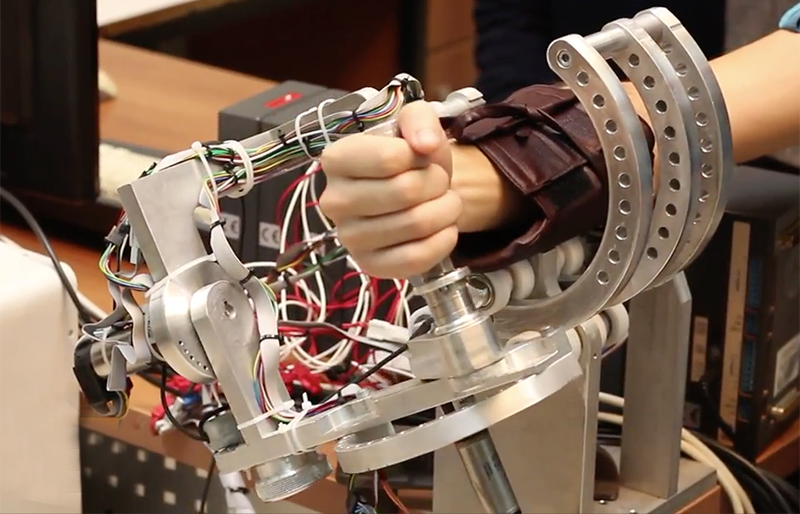Rehabilitation addresses the illnesses or injuries that limit a person’s abilities to perform functional activities. In particular, therapeutic exercises play an important role in rehabilitation. Rehabilitation robots increase their role in those exercises every day. This research aims to develop a complete rehabilitation system that consists of a robot manipulator and a human-computer interface. The system rehabilitates flexion-extension and ulnar-radial deviation movements of the wrist, and pronation-supination movement of the forearm. The control task is to perform passive, active assistive, isotonic, isometric, and isokinetic exercises.
The robot manipulator had three degrees of freedom to able to imitate the mentioned wrist and forearm movements. We derived forward and backward kinematic equations, and presented nonlinear robot dynamics. A hybrid impedance control (HIC) evaluates the position and the force measurements at the tip of the end-effector and regulates the mechanical impedance of patient-robot interaction. The closed-loop system utilized a HIC law to model the exercises. However, the HIC is very sensitive to system uncertainties due to feedback linearization. Therefore, we carefully identified system parameters through a series of trajectory tracking tasks. To this end, we parameterized the robot excitation trajectories for optimal identification. The parameterization was a finite Fourier series the coefficients of which were optimized for minimal sensitivity of the identification against measurement disturbances (i.e., the minimization of the condition number of the regression matrix).
We tested the system safety and performance with healthy subjects. Once the system was validated, we started experimental studies with real patients in Şişli Hamidiye Etfal Training and Research Hospital under the supervision of a physician (Dr. Banu Kuran). The rehabilitation procedure consisted of a range of motion (ROM) and joint force (JF) measurements, and a series of isometric and isotonic exercises. The experimental results showed the effectiveness of the method as the subjects significantly improved their ROM and JF.
Publications
[1] Akdoğan, E., Aktan, M. E., Koru, A. T., Arslan, M. S., Atlıhan, M., and Kuran, B. (2018). Hybrid impedance control of a robot manipulator for wrist and forearm rehabilitation: Performance analysis and clinical results. Mechatronics, 49, 77–91. (link)
Information
| Investigators | Erhan Akdoğan |
| Collaborators | Mehmet Emin Aktan, Ahmet Taha Koru, M. Selçuk Arslan, Murat Atlıhan, Banu Kuran |
| Grant | Supported by The Scientific and Technological Research Council of Turkey (TÜBİTAK) under grant “111M603”. |
| Team | Yıldız Technical University Biomechatronics Research Laboratory |




